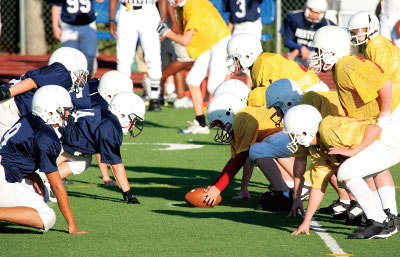Age of Football Player Not Associated With Damage From Head Hits
Abstract
A prospective analysis of 33 middle school and high school players suggests that younger brains are not more susceptible to head impacts than adolescent brains.
Younger children do not appear to be more susceptible to the effects of head impacts from football than adolescents, suggests a small study of middle school and high school football players. These findings run counter to previous research that suggested head impacts in younger football players are associated with greater risk of long-term brain damage.

A team led by researchers at Cincinnati Children’s Hospital Medical Center compared white matter changes in the brains of 12 middle school football players (average age 13) and 21 high school football players (average age 17) over a single football season. White matter is the term used to describe insulated nerve fibers that transmit information across different regions of the brain. The study was published in the November 2019 Clinical Journal of Sports Medicine.
Both groups of athletes received an MRI scan right before the football season started and another shortly after the season ended. All the players had an accelerometer affixed in their helmets that collected data on head impacts during practice and games.
The end-of-season helmet data showed that the high school players sustained significantly more total head impacts and had a higher average g-force per impact compared with the middle school football players. In a typical game, a high school player received an average of 15 impacts of at least 25 gs (the equivalent force a person sustains making a sharp turn in a race car) and one hit of at least 100 gs (concussion inducing). Middle school players on average sustained about seven hits of 25 gs per game and 0.4 hits of 100 gs per game.
The MRI scans showed differences as well. High school players had white matter damage (for example, the insulation on nerve fibers was weaker) in more than a dozen different brain regions after the season, while the middle school players had white matter damage in only three regions.
Regardless of age, players who sustained higher impact hits over the season had greater white matter damage.
“Our work shows that a brain is a brain, and it likely responds to [impact load] about the same in younger kids as in adolescents,” said study investigator Gregory Myer, Ph.D., the research director of the Division of Sports Medicine at Cincinnati Children’s.
He noted that these findings are in contrast to those of a retrospective study of retired football players. This study suggested that football players who sustained head hits from age 10 to 12—a period when white matter undergoes extensive maturation—might be at elevated risk of long-term neurological problems relative to players who sustained their first hits when they were 13 or older. However, this study relied on players’ recollections of head hits and did not have detailed head impact data, Myer said.
“Future studies with larger sample sizes and longitudinal methods consisting of multiple seasons of competitive play are needed to further investigate the age-dependent and region-specific vulnerability of [white matter] to head impact exposure in contact sports,” the researchers wrote.
Myer told Psychiatric News that understanding the comparative risks of head impacts between ages is important in light of the growing chorus to ban youth from playing football and other contact sports, including soccer and hockey.
“There are a lot of physical and social benefits to playing team sports,” Myer said. “Football and other sports do pose some risks, but the real damage comes from physical inactivity, which is the fourth biggest risk factor for early death worldwide.”
Myer noted that his findings do not suggest that football is without risks for children. He said that the sport needs to continue efforts to improve player head safety at every skill level. He said this could be done via improved equipment, such as lighter helmets or compression collars (which increase blood in the head to produce a tighter fit under the helmet), or rule changes like limiting head contact during practice. ■
“Relative Head Impact Exposure and Brain White Matter Alterations After a Single Season of Competitive Football” is posted here.



